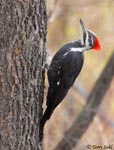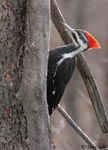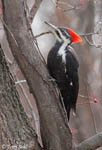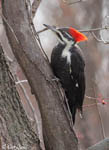| Length: 17 to 19 inches | Wingspan: 30 inches | Seasonality: Rare Visitor |
| ID Keys: Large size, red crest, black body, white striping on face and chin. | ||
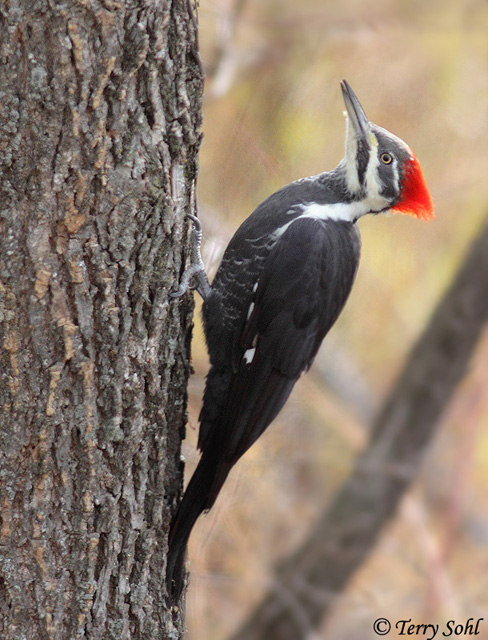 The Pileated
Woodpecker is the largest living woodpecker found in the United States, unless
one believes that the Ivory-billed Woodpecker of the southeast U.S. is still
holding on (I do!!!). With the clearing of most of the forests of the eastern
U.S. in the late 19th and early 20th centuries, Pileated Woodpecker populations
plummeted. As forests have returned, so have Pileated Woodpeckers.
While preferring areas of old-growth deciduous or mixed forest, they have begun
to inhabit second-growth forest as well, and their numbers have increased as
they've learned to adapt to a new environment. Pileated Woodpeckers use their powerful bill to excavate into rotten wood and gain access to
their favorite prey item, carpenter ant nests, as well as to feed on wood-boring insect larvae and other insects.
The Pileated
Woodpecker is the largest living woodpecker found in the United States, unless
one believes that the Ivory-billed Woodpecker of the southeast U.S. is still
holding on (I do!!!). With the clearing of most of the forests of the eastern
U.S. in the late 19th and early 20th centuries, Pileated Woodpecker populations
plummeted. As forests have returned, so have Pileated Woodpeckers.
While preferring areas of old-growth deciduous or mixed forest, they have begun
to inhabit second-growth forest as well, and their numbers have increased as
they've learned to adapt to a new environment. Pileated Woodpeckers use their powerful bill to excavate into rotten wood and gain access to
their favorite prey item, carpenter ant nests, as well as to feed on wood-boring insect larvae and other insects.
Habitat: Prefers deciduous or mixed forest, but can also be found in conifer forest. Strongly prefers mature forest with tall trees, and forest clearing was the primary reason for sharp population declines by 1900. Recently, they've shown some adaptation to second-growth forest.
Diet: Over half of the diet is composed of ants, especially carpenter ants. Will also feed on other ants, wood-boring insect larvae, and other insects. Much of the winter diet is fruits, berries, and nuts.
Behavior: Forages for insects in dead or decaying wood by digging and excavating. Will also climb through foliage for berries and other food items.
Breeding: Possible but unconfirmed breeder in South Dakota. The nest is a cavity in a dead tree or dead tree branch. The female lays between 3 and 5 eggs, and both parents help to incubate them. After the eggs hatch, both parents feed the young. Young typically leave the nest after about 4 weeks, but will stay with the parents for several additional weeks.
Song: Pileated Woodpecker song
Migration: A permanent resident throughout its range, but individual birds may wander widely.
Interactive eBird Map: Click here to access an interactive eBird map of Pileated Woodpecker sightings
Similar Species: Ivory-billed Woodpecker
Feeders: Will attend feeders for suet and nutmeats.
Conservation Status: Currently expanding in numbers and possibly in range after a severe decline by 1900. The IUCN lists the Pileated Woodpecker as a species of "Least Concern".
Further Information: 1) USGS Patuxent Bird Identification InfoCenter, Pileated Woodpecker
2) WhatBird - Pileated Woodpecker
3) Audubon Guide - Pileated Woodpecker
Photo Information: Photo taken on October 27th, 2012 - DeSoto National Wildlife Refuge, Nebraska - Terry Sohl
| Click on the map below for a higher-resolution view |
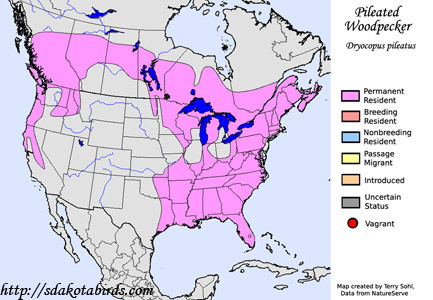 |
| South Dakota Status: Rare permanent resident in the extreme northeastern part of the state. Several recent sightings have occurred in the southeastern part of the state as well. |
Additional Pileated Woodpecker Photos
Click for a higher-resolution version of these photos
